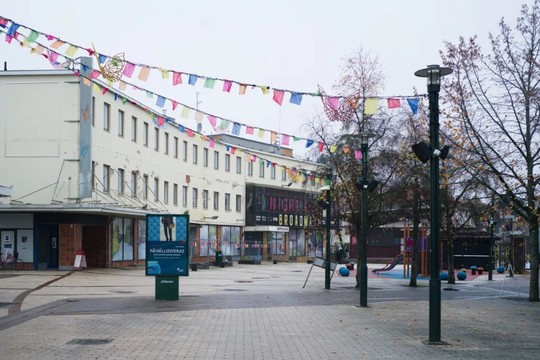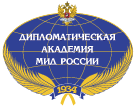Imatra town center has changed utterly, with most downtown stores gone, in Finland on Oct. 24, 2025.
Photo: Bloomberg
In South Karelia, which lies closer to St. Petersburg than Helsinki, shock over Russia’s actions is turning to apprehension at what comes next, Bloomberg writes.
Sari Tukiainen was among the Finns who earned well from their neighbors, as Russian tourists poured over the frontier and filled Imatra’s streets, stores, hotels and spas.
Now, some two years after the border was closed and work began on a high-tech security fence, Tukiainen is again looking at Russia with trepidation.
“If you’d asked me a year ago whether I was afraid, I’d have said not at all, but now my knees tremble a little,” said Jarmo Ikävalko, 73, who runs the Veterans’ Museum in Imatra.
That doesn’t mean Russian forces are about to march across the border, a notion Moscow dismisses as western Russophobia. The Ukrainian war rattles nerves, fueling uncertainty.
As political leaders including German Chancellor Friedrich Merz have said, this isn’t war, but neither is it peace. Whatever it’s termed, it’s reverberating in South Karelia, where the scars of past conflicts run deep.
The Veterans’ Museum is filled with artifacts from the wars between the Soviet Union and Finland. What frightens manager Ikävalko most today, he says, is that the great-power, sphere-of-influence mindset has returned, and that small nations are just pawns in the game. Finland’s boasting about NATO cooperation and the condition of its defensive forces, plus President Alexander Stubb’s remarks that Putin cannot be trusted — “all of that certainly irritates them, our neighbors,” he said.
“The entire Baltic Sea is surrounded by NATO, and it’s naive to think Russia won’t react,” said Ikävalko. “We can only hope no larger international conflict emerges. In the past, Finland was drawn into those wars.”
Finland’s 1,340-kilometer (830-mile) land border with Russia means it guards half of the North Atlantic Treaty Organization’s entire eastern flank. The Finnish government prefers to emphasize its readiness, but in reality the extended border leaves it exposed. It’s a focal point of the so-called drone wall that’s planned as part of Europe’s effort to shield the continent from Russia.
The border has been both a blessing and a curse to the region’s people.
In peaceful times, Finns profited from working in Russia; the local forest industry bought plentiful birch lumber from across the border, and tourists flocked west. Trucks lined up for tens of miles as goods, including new cars, were transported through Finland to Russia.
“Russian customers asked why we couldn’t stay open around the clock,” Tukiainen, 64, recalled of the boom years in the early 2010s. “They bought clothes in stacks — mostly the latest fashion and bling, but even winter coats were sold out by August.”
Finland closed its road border crossings with Russia in November 2023 after Moscow began using asylum seekers as a tool of hybrid attack, encouraging them toward the border checkpoints.
Now there are no Russian customers. Tukiainen will shutter her store by year-end as costs rise and sales decline.
South Karelia estimates it loses €1 million ($1.2 million) in tourism income every day. Imatra’s town center has changed utterly, with most downtown stores gone. The tourists and buses that once clogged the roads have disappeared. Local spas are in deep financial trouble. The city stepped in to help keep the historic State Hotel operating.
Since the closure, the steel plant has shed staff. The region’s three forest-industry firms — UPM-Kymmene Oyj, Stora Enso Oyj and Metsä Group — all announced job cuts. Local health-care services are being pared back.
The unemployment rate in the town of 25,000 is 15%, well above the national average of 9.1%. South Karelia has seen the fastest relative growth in youth unemployment.
 Photo: iltasanomat.fi
Photo: iltasanomat.fi
Sixteen-year-old Sarah Virtanen chairs the Imatra Youth Council, which promotes young people’s wellbeing. She says families are struggling, affecting all aspects of daily life. Many young people leave for the cities to study.
A common refrain in Imatra is whether there should be a plan for when peace eventually comes to Ukraine — when and under what conditions the border could reopen. Many locals feel that conversation can’t happen now; when the national leadership isn’t talking about it, no one is.
Imatra’s marketing and tourism director Jaakko Jäppinen is working on a new strategy for the town to replace the lost income from Russia. The city is courting tourists with nature and cycling as attractions.
Whatever its future, Imatra won’t build itself around Russia again. “Russian money was easy, but it left us with services oversized for the town,” Jäppinen said over lunch in a restaurant originally founded in what was then Enso. “The easy money is gone.”
read more in our Telegram-channel https://t.me/The_International_Affairs

 10:19 09.11.2025 •
10:19 09.11.2025 •























